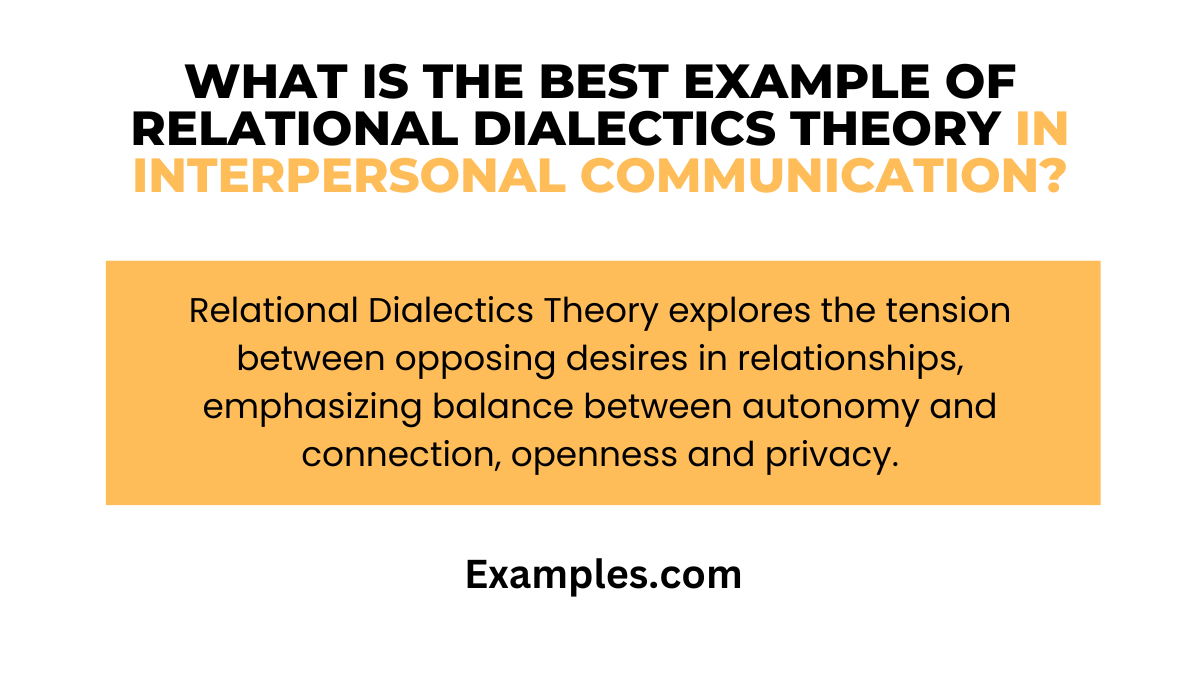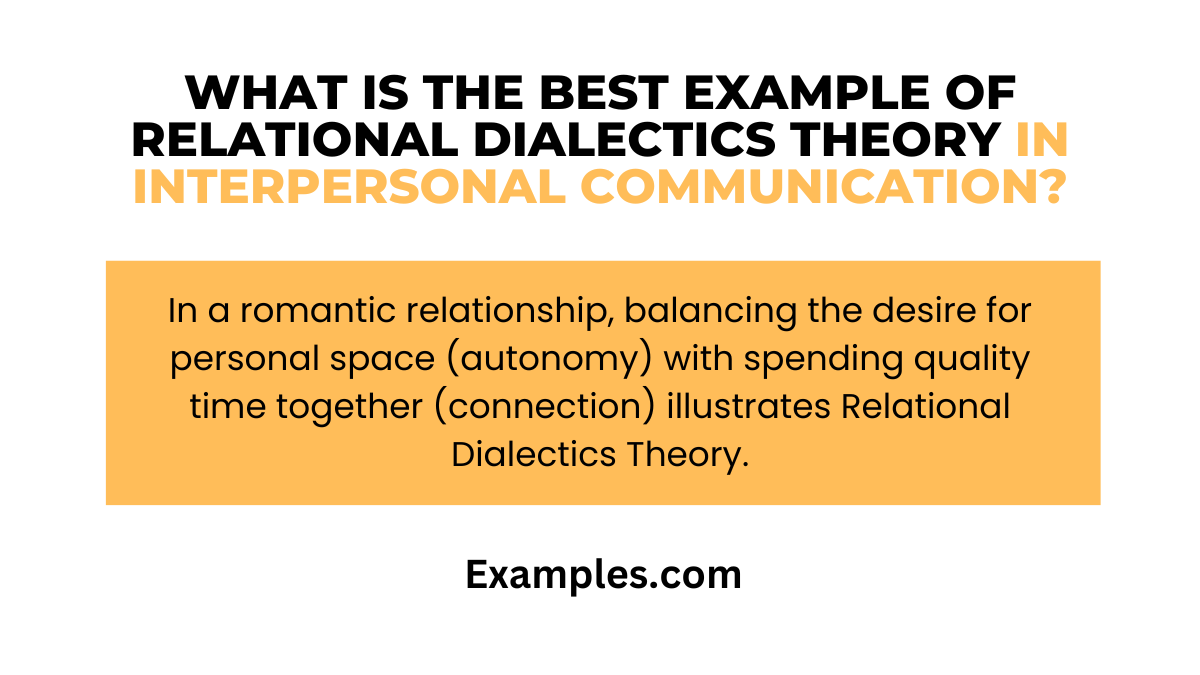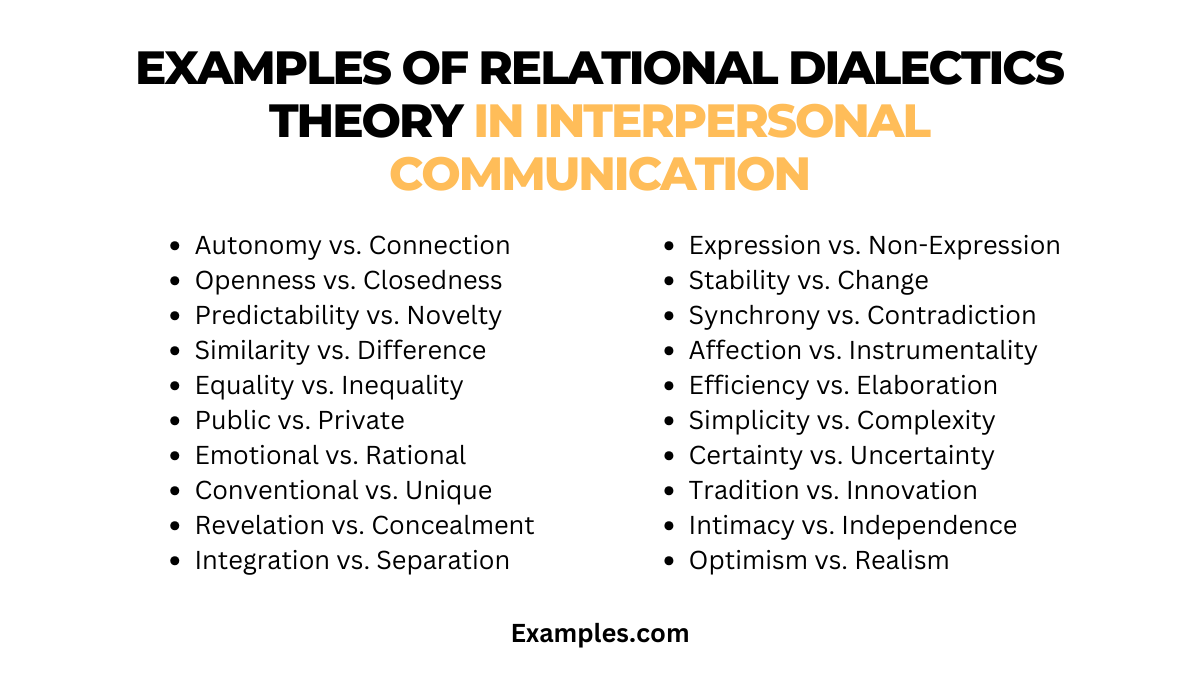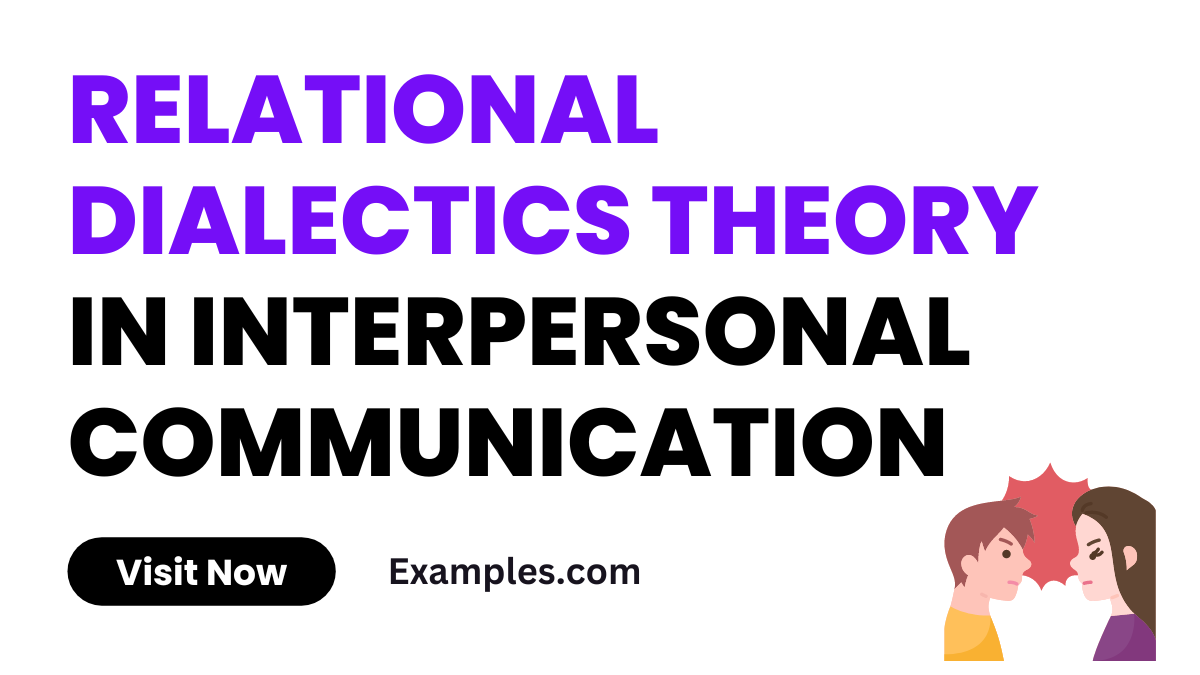19+ Relational Dialectics Theory in Interpersonal Communication Examples
Navigating the complexities of human interaction, Relational Dialectics Theory plays a pivotal role in Interpersonal Communication. This guide delves deep into the theory’s practical applications, offering real-life examples and tips. It’s an essential tool for understanding the dynamic interplay of contrasting forces in personal relationships, aiding in effective communication and conflict resolution. Perfect for students, educators, and communication professionals seeking to enhance their interpersonal skills and knowledge.
What is Relational Dialectics Theory in Interpersonal Communication?

Relational Dialectics Theory, a cornerstone concept in Interpersonal Communication, refers to the ongoing tensions and struggles between opposing desires or needs in personal relationships. It emphasizes the constant push and pull experienced in close interactions, such as autonomy vs. connection, or openness vs. closedness. This theory provides invaluable insight into how individuals navigate these conflicts, fostering deeper understanding and stronger relational bonds.
History
Who created: Leslie Baxter and William Rawlins
Date: 1980
Relational Dialectics Theory, primarily associated with Leslie Baxter and informed by the work of Mikhail Bakhtin, is a cornerstone in understanding the dynamic and ever-changing nature of personal relationships. This theory highlights the ongoing tensions between opposing desires or forces in personal relationships, such as autonomy vs. connection, openness vs. closedness, and predictability vs. novelty. It’s instrumental in understanding how these tensions are managed and negotiated in interpersonal communications.
What is the Best Example of Relational Dialectics Theory in Interpersonal Communication?

A classic example of Relational Dialectics Theory in Interpersonal Communication is a romantic relationship. Here, partners often navigate the tension between autonomy and connection. While each person seeks a sense of independence, they also desire a deep connection with their partner. This theory helps in understanding how couples balance these opposing needs, ensuring a healthy, dynamic relationship. It offers insights into effective communication strategies that respect individuality while fostering closeness and mutual understanding.
20 Examples of Relational Dialectics Theory in Interpersonal Communication

Relational Dialectics Theory in interpersonal communication highlights the ongoing tensions between opposed desires or needs in personal relationships. Understanding this theory offers profound insights into the dynamic interplay of conflicting emotions and desires in communication. Below are 20 unique and distinct examples, each with a brief explanation and example sentences to illustrate how these dialectics manifest in various interpersonal contexts.
- Autonomy vs. Connection: Balancing the need for individual independence against the desire for closeness in a relationship. Example: “I love spending time with you, but I also need some time for myself.”
- Openness vs. Closedness: The tension between wanting to share personal information and the need to maintain privacy. Example: “I want to tell you everything, but there are some things I need to keep to myself.”
- Predictability vs. Novelty: The desire for stability and routine versus the need for new experiences and change. Example: “Let’s try a new restaurant tonight, even though we usually go to our favorite place.”
- Similarity vs. Difference: Balancing the comfort of shared interests against the excitement of differing opinions. Example: “We both love hiking, but I appreciate your interest in art which is new to me.”
- Equality vs. Inequality: Navigating the dynamics of equal or unequal power distribution in communication. Example: “I value your opinion, but in this case, my expertise should lead our decision.”
- Public vs. Private: Determining what aspects of a relationship are shared publicly and what are kept private. Example: “Let’s keep our weekend plans just between us, not for social media.”
- Emotional vs. Rational: Juggling the interplay between emotional responses and logical reasoning in discussions. Example: “I understand your point, but my feelings on this matter are strong.”
- Conventional vs. Unique: The pull between adhering to societal norms and embracing the uniqueness of a relationship. Example: “We don’t have to celebrate our anniversary like everyone else; let’s do what feels right for us.”
- Revelation vs. Concealment: Deciding how much of oneself or a situation to reveal versus what to conceal. Example: “I’ll share my work challenges with you, but not all the office politics.”
- Integration vs. Separation: The balance between a couple’s time together and their time apart. Example: “Weekends are our time, but weekdays let’s focus on our individual goals.”
- Expression vs. Non-Expression: Choosing when to express feelings and when to hold back. Example: “I’m upset, but I’ll discuss it when I’m less emotional.”
- Stability vs. Change: Striving for a stable environment while also welcoming change and growth. Example: “Our routine is comforting, but let’s be open to new experiences.”
- Synchrony vs. Contradiction: Aligning communication styles and timing versus experiencing mismatches in these areas. Example: “We’re not always in sync, but we find ways to understand each other.”
- Affection vs. Instrumentality: The tension between communicating for emotional closeness versus practical purposes. Example: “I love our romantic talks, though sometimes we need to focus on planning.”
- Efficiency vs. Elaboration: Balancing succinct communication with the need for more detailed, elaborate discussions. Example: “I appreciate your brief updates, but sometimes I need more details.”
- Simplicity vs. Complexity: The interplay between desiring straightforward interactions and navigating complex emotions or situations. Example: “Our conversations are usually simple, but this issue requires a deeper discussion.”
- Certainty vs. Uncertainty: The desire for predictability in a relationship versus the acceptance of uncertainty and ambiguity. Example: “I’m not sure where we’re headed, but I’m comfortable exploring this together.”
- Tradition vs. Innovation: Choosing between following traditional patterns of communication and trying new, innovative ways. Example: “We usually celebrate in traditional ways, but let’s try something different this year.”
- Intimacy vs. Independence: Balancing the need for close, intimate communication with the desire for individual autonomy. Example: “I value our intimate moments, but I also cherish my independent pursuits.”
- Optimism vs. Realism: Juggling a positive outlook with a realistic perspective in communication. Example: “I’m optimistic about our plans, but let’s also consider potential challenges.”
Relational Dialectics Theory in Interpersonal Communication in Relationships
Relational Dialectics Theory (RDT), a concept rooted in the principles of Interpersonal Communication, offers a nuanced understanding of how contrasting forces within relationships shape our interactions. This theory is particularly relevant in the context of relationships, where communication plays a pivotal role in maintaining and navigating the complexities of interpersonal connections. Below, we explore ten key points that encapsulate the essence of RDT in the realm of interpersonal relationships:
- Dynamic Nature of Relationships: RDT posits that relationships are not static; they are continually evolving entities shaped by ongoing tensions and contradictions. These dynamic forces drive change and growth within interpersonal relationships.
- Tensions of Autonomy and Connection: A fundamental tension within RDT is the balance between autonomy and connection. Individuals seek a sense of independence, yet also desire intimacy and closeness in relationships. Navigating this tension is crucial for relationship health.
- Struggle between Openness and Privacy: Another core tension involves the desire for openness versus the need for privacy. This relates to how much individuals choose to share or conceal information, impacting the depth and trust within the relationship.
- Novelty and Predictability Dialectic: Relationships oscillate between the need for novelty (new and exciting experiences) and predictability (stability and consistency). Striking a balance here is key to maintaining interest and security in the relationship.
- Internal and External Dialectics: RDT differentiates between internal dialectics (tensions within the relationship itself, such as commitment levels) and external dialectics (tensions influenced by outside factors, like social pressures).
- Managing Dialectical Tensions: Successful management of these tensions involves communication strategies like segmentation (addressing different needs at different times), balance (finding a middle ground), and integration (synthesizing opposing needs).
- Role of Culture in RDT: Cultural norms and values significantly influence how dialectical tensions are experienced and managed, underlining the importance of cultural sensitivity in Interpersonal Communication.
Importance of Relational Dialectics Theory in Interpersonal Communication
Understanding RDT is crucial in comprehending the complexities of Interpersonal Communication. Here are 10 key points that highlight its significance:
- Recognition of Tension: RDT acknowledges the existence of inherent tensions in relationships, such as autonomy versus connection, and openness versus closedness. This recognition helps individuals understand that conflicts and struggles are a natural part of relational dynamics.
- Communication Patterns: RDT sheds light on various communication patterns used to manage these tensions. For example, couples might alternate between periods of intense closeness and independence to balance their needs.
- Diversity of Relationships: The theory recognizes the diversity in relationships by allowing for different ways of experiencing and managing tensions, underscoring that there is no one-size-fits-all approach to communication.
- Adaptability: RDT encourages adaptability in communication strategies. Understanding that relational dynamics are fluid, it suggests that individuals should be flexible in their communication styles.
- Conflict Resolution: By identifying the underlying tensions in conflicts, RDT aids in more effective conflict resolution. It allows individuals to address the root causes of disagreements rather than just the surface issues.
- Personal Growth: Engaging with relational dialectics can lead to personal growth. It challenges individuals to reflect on their communication styles and how they deal with relational tensions.
- Enhanced Understanding: RDT offers a deeper understanding of the complexities of interpersonal relationships, helping individuals to appreciate the multifaceted nature of their interactions with others.
Relational Dialectics Theory reveals the ongoing tensions in personal relationships and their impact on communication. Key to managing these tensions is recognizing and respecting the dynamic interplay of opposites. Effective communication stems from understanding and navigating these contradictions. Embrace openness, adaptability, and empathy to strengthen relationships, ensuring a harmonious balance between conflicting needs and desires.



